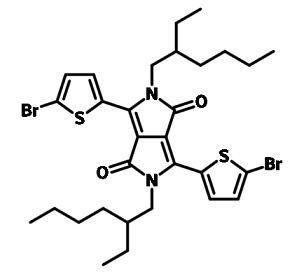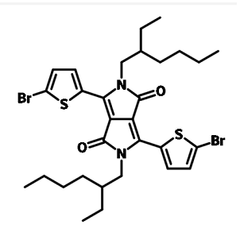DPP-EH-2ThBr
CAS Number 1000623-95-9
Chemistry Building Blocks, Dibromo Monomers, Heterocyclic Building Blocks, Materials, MonomersHigh purity DPP-EH-2ThBr monomer
For the synthesis of small molecules and low band gap semiconducting polymers
Specifications | MSDS | Literature and Reviews
3,6-bis(5-bromothiophen-2-yl)-2,5-bis(2-ethylhexyl)pyrrolo[3,4-c]pyrrole-1,4(2H,5H)-dione, DPP-EH-2ThBr (CAS number 1000623-95-9), is a building block containing a DPP backbone as a strong acceptor unit. It has a planar conjugated bi-cyclic structure engaging stronger π–π interactions. Due to its electron-deficient nature, DPP-EH-2ThBr and its derivatives are used for the synthesis of small molecules and low band-gap polymer semiconductors with OPV, OLED and perovskite solar cells.
Capped with bromide
For facile synthesis
Pyrrolopyrrole building block
For semiconductors, OFETs, and solar cells
Worldwide shipping
Quick and reliable shipping
High purity
>98% High purity
General Information
| CAS Number | 1000623-95-9 |
| Chemical Formula | C30H38Br2N2O2S2 |
| Molecular Weight | 682.57 g/mol |
| Synonyms | 3,6-bis(5-bromothiophen-2-yl)-2,5-bis(2-ethylhexyl)pyrrolo[3,4-c]pyrrole-1,4(2H,5H)-dione |
| Classification / Family | Pyrroles, Pyrrolopyrrole-dione (DPP), Thiophenes, Acceptor, Organic semiconducting materials, Semiconductor synthesis, Building blocks |
Chemical Structure

Product Details
| Purity | >98% |
| Melting Point | N/A |
| Appearance | Dark red/purple solid |
MSDS Documentation
Literature and Reviews
- Synthesis, thin-film morphology, and comparative study of bulk and bilayer heterojunction organic photovoltaic devices using soluble diketopyrrolopyrrole molecules, W. Kylberg et al., Energy Environ. Sci., 4, 3617-3624 (2011); DOI: 10.1039/C1EE01544C.
- Solution processable low bandgap diketopyrrolopyrrole (DPP) based derivatives: novel acceptors for organic solar cells, P. Sonar et al, J. Mater. Chem., 20, 3626-3636 (2010); DOI: 10.1039/B924404B.
- Isomers of dialkyl diketo-pyrrolo-pyrrole: Electron-deficient units for organic semiconductors, B. Zhao et al., Org. Electronics, 13 (11), 2516-2524 (2012); https://doi.org/10.1016/j.orgel.2012.07.015.

 DPP-EH-2ThBr MSDS Sheet
DPP-EH-2ThBr MSDS Sheet